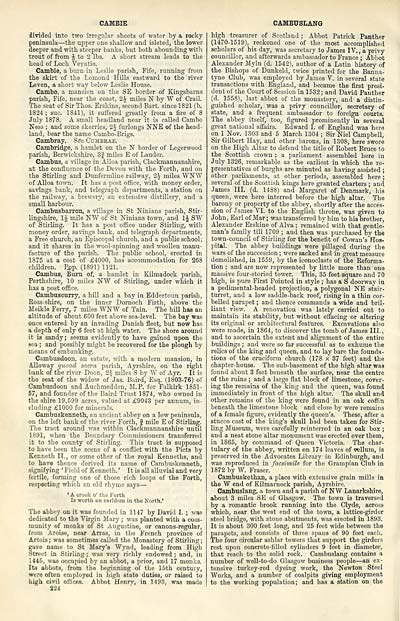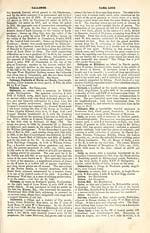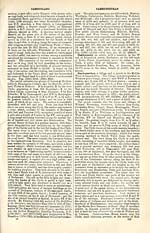Ordnance gazetteer of Scotland
(232) Page 224
Download files
Complete book:
Individual page:
Thumbnail gallery: Grid view | List view

CAMBIE
divided into two irregular sheets of water by a rocky
peninsula — the upper one shallow and isleted, the lower
deeper and with steeper banks, but both abounding with
trout of from J to 2 lbs. A short stream leads to the
head of Loch Veyatie.
Cambie, a burn in Leslie parish, Fife, running from
the skirt of the Lomond Hills eastward to the river
Leven, a short way below Leslie House.
Cambo, a mansion on the SE border of Kingsbarns
parish, Fife, near the coast, 2J miles K by ¥ of Crail.
The seat of Sir Thos. Erskine, second Bart, since 1821 (b.
1S24 ; sue. 1S41), it suffered greatly from a fire of 8
July 1878. A small headland near it is called Cambo
Ness ; and some skerries, 2J furlongs NNE of the head-
land, bear the name Cambo-Brigs.
Cambray. See Cumbrae.
Cambridge, a hamlet on the N border of Legerwood
parish, Berwickshire, 3J miles E of Lauder.
Cambus, a village in Alloa parish, Clackmannanshire,
at the confluence of the Devon with the Forth, and on
the Stirling and Dunfermline railway, 2J miles WW
of Alloa town. It has a post office, with money order,
savings bank, and telegraph departments, a station on
the railway, a brewery, an extensive distillery, and a
small harbour.
Cambusbarron, a village in St Ninians parish, Stir-
lingshire, 1^ mile NW of St Ninians town, and 1J SW
of Stirling. It has a post office under Stirling, with
money order, savings bank, and telegraph departments,
a Free church, an Episcopal church, and a public school ;
and it shares in the wool-spinning and woollen manu-
facture of the parish. The public school, erected in
1875 at a cost of £4000, has accommodation for 268
children. Pop. (1891) 1121.
Cambus, Burn of, a hamlet in Kilmadock parish,
Perthshire, 10 miles SW of Stirling, under which it
has a post office.
Cambuscurry, a hill and a bay in Eddertoun parish,
Ross-shire, on the inner Dornoch Firth, above the
Meikle Ferry, 7 miles WNW of Tain. The hill has an
altitude of about 600 feet above sea-level. The bay was
once entered by an invading Danish fleet, but now has
a depth of only 6 feet at high water. The shore around
it ia sandy; seems evidently to have gained upon the
sea ; and possibly might be recovered for the plough by
means of embanking.
Cambusdoon, an estate, with a modern mansion, in
Alloway quoad sacra parish, Ayrshire, on the right
bank of the river Doon, 24 miles S by W of Ayr. It is
the seat of the widow of Jas. Baird, Esq. (1803-76) of
Cambusdoon and Auchmedden, M.P. for Falkirk 1851-
57, and founder of the Baird Trust 1874, who owned in
the shire 19,599 acres, valued at £9043 per annum, in-
cluding £1000 for minerals.
Cambuskenneth, an ancient abbey on a low peninsula,
on the left bank of the river Forth, § mile E of Stirling.
The tract around was within Clackmannanshire until
1891, when the Boundary Commissioners transferred
it to the county of Stirling. This tract is supposed
to have been the scene of a conflict with the Picts by
Kenneth II., or some other of the royal Kenneths, and
to have thence derived its name of Cambuskenneth,
signifying 'Field of Kenneth.' It is all alluvial and very
fertile, forming one of those rich loops of the Forth,
respecting which an old rhyme says —
* A crook o' the Forth
Is worth an earldom in the North.'
The abbey on it was founded in 1147 by David I. ; was
dedicated to the Virgin Mary ; was planted with a com-
munity of monks of St Augustine, or canons-regular,
from Aroise, near Arras, in the French province of
Artois ; was sometimes called the Monastery of Stirling ;
five name to St Mary's Wynd, leading from Higli
treet in Stirling ; was very richly endowed ; and, in
1445, was occupied by an abbot, a prior, and 17 monks.
Its abbots, from the beginning of the 15th century,
were often employed in high state duties, or raised to
high civil offices. Abbot Henrv, in 1493, was made
224
CAMBUSLANG
high treasurer of Scotland; Abbot Patrick Panther
(1470-1519), reckoned one of the most accomplished
scholars of his day, was secretary to James IV. , a privy
councillor, and afterwards ambassador to France ; Abbot
Alexander Myln (d. 1542), author of a Latin history of
the Bishops of Dunkeld, twice printed for the Banna-
tyne Club, was employed by James V. in several state
transactions with England, and became the first presi-
dent of the Court of Session in 1532 ; and David Panther
(d. 1558), last abbot of the monastery, and a distin-
guished scholar, was a privy councillor, secretary of
state, and a frequent ambassador to foreign courts.
The abbey itself, too, figured prominently in several
great national affairs. Edward I. of England was here
on 1 Nov. 1303 and 5 March 1304 ; Sir Niel Campbell,
Sir Gilbert Hay, and other barons, in 1308, here swore
on the High Altar to defend the title of Robert Bruce to
the Scottish crown ; a parliament assembled here in
July 1326, remarkable as the earliest in which the re-
presentatives of burghs are minuted as having assisted ;
other parliaments, at other periods, assembled here ;
several of the Scottish kings here granted charters ; and
James III. (d. 1488) and Margaret of Denmark, his
queen, were here interred before the high altar. The
barony or property of the abbey, shortly after the acces-
sion of James VI. to the English throne, was given to
John , Earl of Mar ; was transferred by him to his brother,
Alexander Erskine of Alva ; remained with that gentle-
man's family till 1709 ; and then was purchased by the
town-council of Stirling for the benefit of Cowan's Hos-
pital. The abbey buildings were pillaged during the
wars of the succession ; were sacked and in great measure
demolished, in 1559, by the iconoclasts of the Reforma-
tion ; and are now represented by little more than one
massive four-storied tower. This, 35 feet square and 70
high, is pure First Pointed in style ; has a S doorway in
a pedimental-headed projection, a polygonal NE stair-
turret, and a low saddle-back roof, rising in a thin cor-
belled parapet ; and thence commands a wide and bril-
liant view. A renovation was lately carried out to
maintain its stability, but without effacing or altering
its original or architectural features. Excavations also
were made, in 1864, to discover the tomb of James III.,
and to ascertain the extent and alignment of the entire
buildings ; and were so far successful as to exhume the
relics of the king and queen, and to lay bare the founda-
tions of the cruciform church (178 x 37 feet) and the
chapter-house. The sub-basement of the high altar was
found about 3 feet beneath the surface, near the centre
of the ruins ; and a large flat block of limestone, cover-
ing the remains of the king and the queen, was found
immediately in front of the high altar. The skull and
other remains of the king were found in an oak coffin
beneath the limestone block and close by were remains
of a female figure, evidently the queen's. These, after a
stucco cast of the king's skull had been taken for Stir-
ling Museum, were carefully reinterred in an oak box ;
and a neat stone altar monument was erected over them,
in 1865, by command of Queen Victoria. The char-
tulary of the abbey, written on 174 leaves of vellum, is
preserved in the Advocates Library in Edinburgh, and
was reproduced in facsimile for the Grampian Club in
1872 by W. Fraser.
Cambuskethan, a place with extensive grain mills in
the W end of Kilmarnock parish, Ayrshire.
Cambuslang, a town and a parish of NW Lanarkshire,
about 3 miles SE of Glasgow. The town is traversed
by a romantic brook running into the Clyde, across
which, near the west end of the town, a lattice-girder
steel bridge, with stone abutments, was orected in 1893.
It is about 300 feet long, and 25 feet wide between the
parapets, and consists of three spans of 90 feet each.
The four circular ashlar towers that support the girders
rest upon concreto-filled cylinders 9 feet in diameter,
that reach to the solid rock. Cambuslang contains a
number of well-to-do Glasgow business people — an ex-
tensive turkey-red dyeing work, the Newton Steel
Works, and a number of coalpits giving employment
to the working population; and has a station on the
divided into two irregular sheets of water by a rocky
peninsula — the upper one shallow and isleted, the lower
deeper and with steeper banks, but both abounding with
trout of from J to 2 lbs. A short stream leads to the
head of Loch Veyatie.
Cambie, a burn in Leslie parish, Fife, running from
the skirt of the Lomond Hills eastward to the river
Leven, a short way below Leslie House.
Cambo, a mansion on the SE border of Kingsbarns
parish, Fife, near the coast, 2J miles K by ¥ of Crail.
The seat of Sir Thos. Erskine, second Bart, since 1821 (b.
1S24 ; sue. 1S41), it suffered greatly from a fire of 8
July 1878. A small headland near it is called Cambo
Ness ; and some skerries, 2J furlongs NNE of the head-
land, bear the name Cambo-Brigs.
Cambray. See Cumbrae.
Cambridge, a hamlet on the N border of Legerwood
parish, Berwickshire, 3J miles E of Lauder.
Cambus, a village in Alloa parish, Clackmannanshire,
at the confluence of the Devon with the Forth, and on
the Stirling and Dunfermline railway, 2J miles WW
of Alloa town. It has a post office, with money order,
savings bank, and telegraph departments, a station on
the railway, a brewery, an extensive distillery, and a
small harbour.
Cambusbarron, a village in St Ninians parish, Stir-
lingshire, 1^ mile NW of St Ninians town, and 1J SW
of Stirling. It has a post office under Stirling, with
money order, savings bank, and telegraph departments,
a Free church, an Episcopal church, and a public school ;
and it shares in the wool-spinning and woollen manu-
facture of the parish. The public school, erected in
1875 at a cost of £4000, has accommodation for 268
children. Pop. (1891) 1121.
Cambus, Burn of, a hamlet in Kilmadock parish,
Perthshire, 10 miles SW of Stirling, under which it
has a post office.
Cambuscurry, a hill and a bay in Eddertoun parish,
Ross-shire, on the inner Dornoch Firth, above the
Meikle Ferry, 7 miles WNW of Tain. The hill has an
altitude of about 600 feet above sea-level. The bay was
once entered by an invading Danish fleet, but now has
a depth of only 6 feet at high water. The shore around
it ia sandy; seems evidently to have gained upon the
sea ; and possibly might be recovered for the plough by
means of embanking.
Cambusdoon, an estate, with a modern mansion, in
Alloway quoad sacra parish, Ayrshire, on the right
bank of the river Doon, 24 miles S by W of Ayr. It is
the seat of the widow of Jas. Baird, Esq. (1803-76) of
Cambusdoon and Auchmedden, M.P. for Falkirk 1851-
57, and founder of the Baird Trust 1874, who owned in
the shire 19,599 acres, valued at £9043 per annum, in-
cluding £1000 for minerals.
Cambuskenneth, an ancient abbey on a low peninsula,
on the left bank of the river Forth, § mile E of Stirling.
The tract around was within Clackmannanshire until
1891, when the Boundary Commissioners transferred
it to the county of Stirling. This tract is supposed
to have been the scene of a conflict with the Picts by
Kenneth II., or some other of the royal Kenneths, and
to have thence derived its name of Cambuskenneth,
signifying 'Field of Kenneth.' It is all alluvial and very
fertile, forming one of those rich loops of the Forth,
respecting which an old rhyme says —
* A crook o' the Forth
Is worth an earldom in the North.'
The abbey on it was founded in 1147 by David I. ; was
dedicated to the Virgin Mary ; was planted with a com-
munity of monks of St Augustine, or canons-regular,
from Aroise, near Arras, in the French province of
Artois ; was sometimes called the Monastery of Stirling ;
five name to St Mary's Wynd, leading from Higli
treet in Stirling ; was very richly endowed ; and, in
1445, was occupied by an abbot, a prior, and 17 monks.
Its abbots, from the beginning of the 15th century,
were often employed in high state duties, or raised to
high civil offices. Abbot Henrv, in 1493, was made
224
CAMBUSLANG
high treasurer of Scotland; Abbot Patrick Panther
(1470-1519), reckoned one of the most accomplished
scholars of his day, was secretary to James IV. , a privy
councillor, and afterwards ambassador to France ; Abbot
Alexander Myln (d. 1542), author of a Latin history of
the Bishops of Dunkeld, twice printed for the Banna-
tyne Club, was employed by James V. in several state
transactions with England, and became the first presi-
dent of the Court of Session in 1532 ; and David Panther
(d. 1558), last abbot of the monastery, and a distin-
guished scholar, was a privy councillor, secretary of
state, and a frequent ambassador to foreign courts.
The abbey itself, too, figured prominently in several
great national affairs. Edward I. of England was here
on 1 Nov. 1303 and 5 March 1304 ; Sir Niel Campbell,
Sir Gilbert Hay, and other barons, in 1308, here swore
on the High Altar to defend the title of Robert Bruce to
the Scottish crown ; a parliament assembled here in
July 1326, remarkable as the earliest in which the re-
presentatives of burghs are minuted as having assisted ;
other parliaments, at other periods, assembled here ;
several of the Scottish kings here granted charters ; and
James III. (d. 1488) and Margaret of Denmark, his
queen, were here interred before the high altar. The
barony or property of the abbey, shortly after the acces-
sion of James VI. to the English throne, was given to
John , Earl of Mar ; was transferred by him to his brother,
Alexander Erskine of Alva ; remained with that gentle-
man's family till 1709 ; and then was purchased by the
town-council of Stirling for the benefit of Cowan's Hos-
pital. The abbey buildings were pillaged during the
wars of the succession ; were sacked and in great measure
demolished, in 1559, by the iconoclasts of the Reforma-
tion ; and are now represented by little more than one
massive four-storied tower. This, 35 feet square and 70
high, is pure First Pointed in style ; has a S doorway in
a pedimental-headed projection, a polygonal NE stair-
turret, and a low saddle-back roof, rising in a thin cor-
belled parapet ; and thence commands a wide and bril-
liant view. A renovation was lately carried out to
maintain its stability, but without effacing or altering
its original or architectural features. Excavations also
were made, in 1864, to discover the tomb of James III.,
and to ascertain the extent and alignment of the entire
buildings ; and were so far successful as to exhume the
relics of the king and queen, and to lay bare the founda-
tions of the cruciform church (178 x 37 feet) and the
chapter-house. The sub-basement of the high altar was
found about 3 feet beneath the surface, near the centre
of the ruins ; and a large flat block of limestone, cover-
ing the remains of the king and the queen, was found
immediately in front of the high altar. The skull and
other remains of the king were found in an oak coffin
beneath the limestone block and close by were remains
of a female figure, evidently the queen's. These, after a
stucco cast of the king's skull had been taken for Stir-
ling Museum, were carefully reinterred in an oak box ;
and a neat stone altar monument was erected over them,
in 1865, by command of Queen Victoria. The char-
tulary of the abbey, written on 174 leaves of vellum, is
preserved in the Advocates Library in Edinburgh, and
was reproduced in facsimile for the Grampian Club in
1872 by W. Fraser.
Cambuskethan, a place with extensive grain mills in
the W end of Kilmarnock parish, Ayrshire.
Cambuslang, a town and a parish of NW Lanarkshire,
about 3 miles SE of Glasgow. The town is traversed
by a romantic brook running into the Clyde, across
which, near the west end of the town, a lattice-girder
steel bridge, with stone abutments, was orected in 1893.
It is about 300 feet long, and 25 feet wide between the
parapets, and consists of three spans of 90 feet each.
The four circular ashlar towers that support the girders
rest upon concreto-filled cylinders 9 feet in diameter,
that reach to the solid rock. Cambuslang contains a
number of well-to-do Glasgow business people — an ex-
tensive turkey-red dyeing work, the Newton Steel
Works, and a number of coalpits giving employment
to the working population; and has a station on the
Set display mode to: Large image | Transcription
Images and transcriptions on this page, including medium image downloads, may be used under the Creative Commons Attribution 4.0 International Licence unless otherwise stated. ![]()
| Gazetteers of Scotland, 1803-1901 > Ordnance gazetteer of Scotland > (232) Page 224 |
|---|
| Permanent URL | https://digital.nls.uk/97396030 |
|---|

